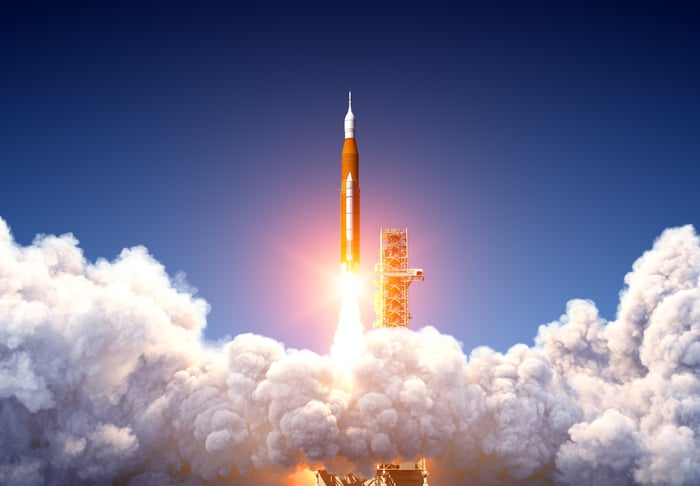For more than a decade, NASA has been building a new mega-rocket, the Space Launch System or SLS, a $2 billion-plus, bright-orange rocket ship that can carry 70 tons of cargo to orbit. It's also the rocket NASA hopes will return American astronauts to the moon, and then take them to Mars. Everyone who is anyone in space -- Boeing (BA 0.00%), Lockheed Martin (LMT 1.89%), Northrop Grumman (NOC 2.31%), and Aerojet Rocketdyne Holdings (AJRD) -- has a piece of this project.
And in as little as two months, it may finally fly.

Image source: Getty Images.
Better late than never
When NASA first announced the SLS project in 2010, it set an ambitious schedule for development that assumed a first flight as early as 2016 -- but obviously, that didn't happen. After repeated delays that have pushed the project way behind schedule (and over budget to boot), NASA has confirmed that SLS is finally approaching the finish line.
After a partially successful pre-launch fueling test on June 20, NASA Associate Administrator for Exploration Systems Development Jim Free told Ars Technica the space agency is "targeting" a first launch date in late August or early September. So this is a goal, rather than a deadline.
This SLS launch, dubbed Artemis I, will send the rocket on a three-week-long looping path out past the moon and then back to Earth, where its unmanned Orion crew module will splash down in the ocean. If all goes well, the Artemis I mission will also confirm SLS's status as the biggest, most powerful operational space rocket on Earth.
Or maybe not.
America's next space race
Vying with SLS for the title of world's biggest rocket is a new rocket ship from space titan SpaceX -- and SpaceX, too, is rushing to get its rocket ready for an imminent launch.
Last month, the Federal Aviation Administration (FAA) signed off on an environmental impact assessment that will permit SpaceX to use its Boca Chica launch site in Texas for orbital launches of its new Starship super-rocket. Combined with its "Super Heavy" booster, Starship will boast a payload capacity of 100 tons (roughly 50% more than SLS) on launches to Earth orbit, to the moon -- and yes, to Mars as well.
And once it starts flying, Starship, not SLS, will become the world's biggest operational rocket.
So when will Starship start flying -- and will it do so soon enough to prevent SLS from taking the title of world's biggest spaceship? It looks like this race will go down to the wire. While the FAA has signed off on Starship launching to orbit from Texas, the approval comes with caveats: 75 separate remedial actions SpaceX must complete before an orbit launch can happen. Ever ambitious, SpaceX thinks it can get the work done in time for a July launch, which would beat SLS to the punch.
Yet SpaceX founder Elon Musk was exceedingly coy -- one might even say wily -- in how he phrased SpaceX's Starship ambitions in a couple of tweets last month, saying first:
Starship will be ready to fly next month. I was in the high bay & mega bay late last night reviewing progress.
-- Elon Musk (@elonmusk) June 14, 2022
And later:
We will have a second Starship stack ready to fly in August and then monthly thereafter
-- Elon Musk (@elonmusk) June 14, 2022
But notice the details. Starship will be ready to fly in July -- perhaps even two separate Starships. But that doesn't mean SpaceX itself is promising to have checked every box on the FAA's checklist for getting its spaceport ready to support those flights. In that case, it won't really be SpaceX's fault -- but the FAA's -- if launch doesn't happen until August or even September. Many space pundits are therefore suggesting that because of all the environmental hoops SpaceX must jump through, an August or September launch is more likely -- for both SLS and Starship.
What it means for investors
As a result, right now it seems there's a good chance SLS will beat Starship to orbit -- beat it to the moon, in fact, considering that that's where Artemis I is headed. And that's good news for investors banking on taxpayer funds continuing to flow through the SLS project and its contractors.
For a brief, shining moment, NASA's Space Launch System will claim the crown of "biggest rocket ship on Earth," just as its Saturn V rocket once did. That accomplished, I imagine NASA can declare itself vindicated on the $35 billion cost of developing SLS. (As Boeing has argued, that's just one-quarter of what it cost to develop Saturn V, after all, when adjusted for inflation.)
Longer-term, I still believe that once Starship is operational, its significantly cheaper cost per flight will make SLS obsolete, doomed to be replaced by the cheaper Starship. In the meantime, even a temporary victory for SLS will allow NASA to argue SLS should be kept alive throughout the Artemis moon project. And this should ensure that billions of taxpayer dollars, earmarked for Artemis, continue to flow through SLS into the bank accounts of Boeing, Lockheed Martin, Northrop Grumman, and Aerojet Rocketdyne.





